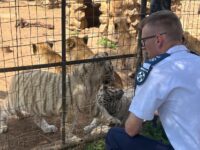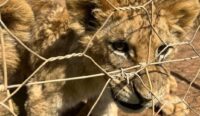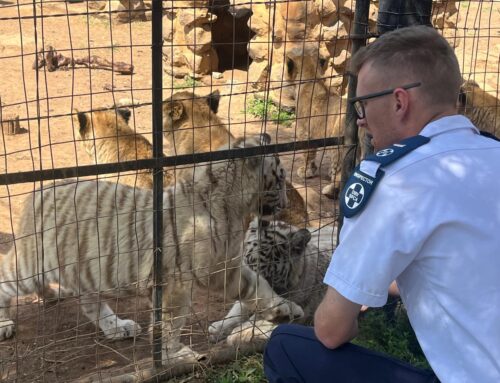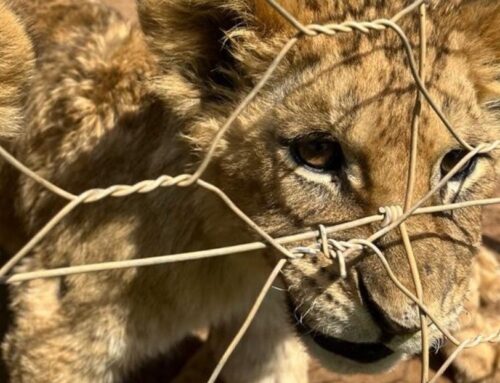Download full report here THE NSPCA CHALLENGES THE CAPTIVE LION INDUSTRY
Since the time that canned lion hunting was exposed, the National Council of SPCAs (NSPCA) has raised opposition to the captive lion industry in its entirety and has been serving in the interest of thousands of captive lions for more than a decade. In a report referred to as the “NSPCA Challenges the Captive Lion Industry – A positive change for all wildlife in South Africa”, released in February 2021 prior to the release of the high-level panel Recommendation Report – the NSPCA provides for detailed themed sections that serve to provide insight in terms of the following:
- Who the NSPCA is in terms of executing our statutory mandate by preventing animal cruelty and promoting the welfare of all animals.
- The critical role that the NSPCA carries out in society as recognised by the Constitutional Court of South Africa.
- Outlining the various historic past and current efforts made by the NSPCA to address the captive lion industry, including animal welfare and cruelty associated with the industry.
- A comprehensive and detailed exposé and summary of the various animal welfare concerns and issues found during inspections as far back as 1999.
- The provision of strong arguments to support the fact that the industry serves no conservation value, including the blatant disconnect to the ethical issues embedded in the utilisation of captive lions.
- Providing justification in terms of why the NSPCA undertook litigation measures, which in part was based on one of the outcomes from the CoP17 Conference to the Convention on International Trade in Endangered Species of Wild Fauna and Flora (CITES) which included that the Department of Forestry, Fisheries and the Environment (DFFE) would establish a quota for bones derived from captive breeding facilities in South Africa. Whilst lion bone and skeletons have been exported from South Africa historically in an unlimited manner, the CoP17 CITES decision provided a gateway for further commercialisation of the captive lion industry, all whilst animal welfare considerations remained excluded.
- The NSPCA’s decision to legally challenge the captive lion and lion bone trade industry involved a combination of the historical and continued efforts made by the NSPCA to address the various issues and concerns with regards to the captive lion industry, only to be ignored with no solutions, including the various implications and consequences the formalisation of a lion bone export quota following CoP17 of CITES would give effect to from an ethical, conservation and animal welfare perspective.
- On the 6th August 2019, the NSPCA was vindicated when the court handed down a precedent-setting judgement requiring welfare considerations to be taken into account when making conservation and wildlife use policy decisions and declaring both the 2017 and 2018 lion bone export quotas as unlawful and unconstitutional and that whilst the mandate of the DFFE is not welfare, it cannot ignore and should take consideration for animal welfare in decisions around conservation policy.
- Ultimately, this court ruling not only resulted in a positive change for captive lions in South Africa, but for all wildlife in South Africa, including the environment they are dependent on for survival.
Minister Barbara Creecy from the DFFE has recently adopted the recommendations made by her appointed High-level Panel to ultimately bring an end to the controversial captive lion industry. The NSPCA was an active stakeholder in this process and welcomes the long-last recognition to bring an end to irresponsible, inhumane and unsustainable practices. The NSPCA wishes to congratulate Minister Creecy, her department and all who made submissions for consideration that will shape and transform the future of South Africa’s wildlife industry to be a reflection of true conservation and management practices of South Africa’s biodiversity.
–END–
If you are as passionate about animals and their well-being as we are, consider supporting our causes by donating.
Latest News Posts
Will You Be the One Who Takes Action?
Most people will scroll past this. But will you be the one who stands up for animals?
Animal welfare isn’t always in the spotlight, but it changes lives – for every neglected, abused, or suffering animal we help. Our teams work tirelessly, often behind the scenes, ensuring animals across South Africa are protected.
This work is relentless. The challenges are immense. But with more hands, hearts, and resources, we can do even more.
The equation is simple: the more supporters we have, the greater our reach, the stronger our impact.
Be part of the change. Become an NSPCA Project Partner today. From just R50 per month, you can help ensure that no animal suffers in silence.








